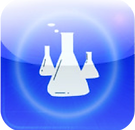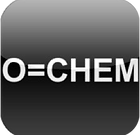
NUS
CM1121 Organic Chemistry 1
This module covers the characteristic properties, methods of preparation, and reactions of alkanes/cycloalkanes, alkenes, alkynes, benzene and other aromatic compounds, alkyl halides; alcohols; ethers; epoxides, phenols, aldehydes and ketones; carboxylic acids and their derivatives; amines. |
Formulae is a great app for when you want to study on the go, or you're just a little forgetful with all those important equations! Contains chemistry and maths content, including functional groups, named reactions (including mechanisms) and, of course, loads of equations!
SPRESImobile provides you with a powerful and convenient way to access ChemReact, containing around 410,000 chemical reactions and related references. InfoChem created ChemReact for chemists who need information about effective reaction transformations.
Khan Academy allows you to learn almost anything for free. Our app is the best way to view Khan Academy’s complete library of over 4,200 videos. We cover a massive number of science topics such as biology, chemistry, and physics, and even the humanities with playlists on finance and history.
Over 250 Named Reactions are available to you for free. Named organic chemistry reactions are a fundamental part of every chemist's toolkit. ReactionFlash helps you learn and understand named reactions. Not only does the app give you the reaction, it also shows you the known mechanism, published examples from Reaxys, and even allows you to test your skills with the ReactionFlash Quiz.
Organic Chemistry Essentials is the perfect addition to your textbook and a great mobile companion. Designed by a former organic chemistry instructor, Organic Chemistry Essentials is fun and covers many topics such as reagents, synthetic strategy, and organic reactions. The app also has little-known trick reactions, clues to organic reactions, and organic chemistry nerd humor.
This app contains organic elements,reaction and mechanism list and search function. The available compounds includes Alkanes, Alkenes, Alkynes, Aromatic compounds, Halogen derivatives, Alcohols, Phenols, Thiols, Ethers, Epoxides, Amines, Aldehydes and ketones, Carboxylic acids.
Search and examine 25 (free) or all 250 (paid) important chemical transformations from the best-selling book Strategic Applications of Named Reactions in Organic Synthesis by László Kürti and Barbara Czakó.
Open the most common 3D molecule file formats saved on your SD card or choose from one of the 243 included molecules in the molecule library. Chemicals can also be searched and downloaded directly from the ChemDB and PDB Chem websites.
Organic Chemistry Nomenclature is the ultimate way for Chemistry students to study and memorize the names and structures of all the important chemical functional groups. Quiz yourself, and do it in a way that's fun and logically organized.
This app is a complete OChem study guide for college and university level Organic Chemistry students. A simple and easy to use way of organizing all the necessary information for organic chemistry! This app can also be used as flashcards to help learn all the essential organic chemistry reactions
Chemistry Quiz is an application designed to help students prepare for basic chemistry course quizzes and exams. The chemistry quizzes cover most of the sections in the beginner chemistry textbooks. The quizzes are combination of easy, medium and hard questions and each section is targeted to match the contents in most commonly used Chemistry textbooks in US, UK, Australia and Canada .
O=Chem was made for you so you can spend your time studying organic chemistry instead of making flashcards. Makes learning functional groups easy. Plain, simple, and FREE!
This app will help you learn the reactions commonly encountered in organic chemistry courses. In just seconds, you can set up a deck of flash cards for the reaction topics of your choice.
Learn Organic Chemistry: Nomenclature LITE will help you master the naming of organic compounds. It features clear, concise, interactive lessons on how to name some of the compounds commonly encountered in an organic chemistry course.
Key features:
•Complete JEE syllabus covering all sections
•Lessons Prepared by IIT/NIT Topper
•Question Bank
•Mock tests
The Atomdroid app is a computational chemistry tool for the Android platform. It can be used as a molecular viewer/builder and contains local optimization and Monte Carlo simulation features.
This app provides a visual approach to organic chemistry. It is not meant to replace a textbook - it should be seen as a visual aid. The molecules and reactions are just briefly described. The main focus are the numerous animations of the molecules and reactions. Currently only alkanes, alkenes and alkynes are described. You can test your knowledge through a quiz of 40 questions.
Chemistry Toolbox is an app that provides quick access to the main data in chemistry within easy reach. The functionalities that are present are: periodic table, a few calculation tools for solution preparation, physical and chemical constants, pH indicators, NMR related information, data for common solvents, pKa information, amino acids, standard reduction potentials and organic functional groups.
Tap OChem Lite covers many organic reactions and concepts. The reactions and concepts included are some of the most common from the one year sequence of undergraduate organic chemistry that is offered at major colleges and universities. Tap OChem Lite displays organic chemistry reactions and concepts in high quality animations. The Lite version will give you a taste of the full version where more than 100 animations and descriptions are available. Each animation has an accompanying text that drills down to the main features of each reaction or concept. These are short, quick to find, descriptions with important information regarding each reaction or concept. For each reaction, text descriptions include electron pushing diagrams.
The app provides puzzles of chair conformations (ring flips) for learning spatial reasoning, which is a key for mastering organic chemistry. This visual pattern puzzle game provides a fun and fast method for mastering chair (or cyclohexane) ring flips. During game play, as levels increase, so does the complexity of these organic chemistry puzzles against the clock. No understanding of organic chemistry is required to play the game. With over 13 challenging levels, this app will help the user to master this tough concept with ease.
Complete Chemistry focuses on students learning chemistry. The app covers tutorials, solver, quiz, formulas and dictionary.
MolPad is a chemical structure drawing application for the Android platform. You can draw structures from scratch or load them from ChemSpider and modify them. Structures can be emailed in Molfile format.























